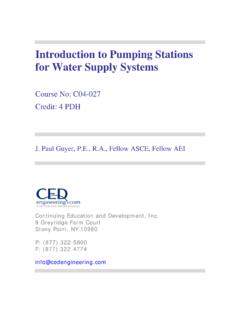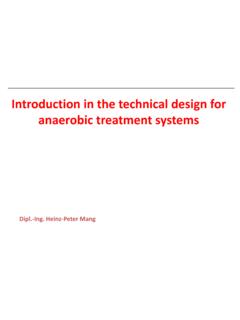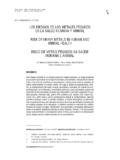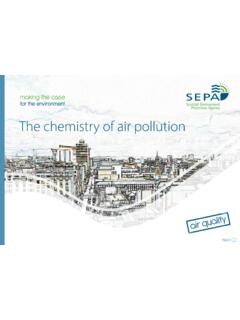Transcription of Adsorption with Granular Activated Carbon (GAC)
1 PIERO M. ARMENANTENJITA dsorption withGranular Activated Carbon (GAC) PIERO M. ARMENANTENJITA dsorption Processes UtilizingGranular Activated Carbon (GAC)for Wastewater TreatmentIn all these processes the wastewater iscontacted with Granular Activated Carbon (GAC)typically in a semi-batch or continuous that utilize this type of Carbon include: Fixed-bed or expanded-bed Adsorption Moving-bed Adsorption Fluidized-bed adsorptionPIERO M. ARMENANTENJITF ixed-Bed and Expanded-BedAdsorption SystemsWastewaterinWastewateroutWastewat eroutWastewaterinFixed-BedExpanded-BedPI ERO M. ARMENANTENJITM odes of Operation of Fixed-Bed andExpanded-Bed Systems Downflow Fixed-bed Upflow-Expanded-bed (if the wastewater velocityexpands the bed by about 10% or higher)-Fixed-bedPIERO M. ARMENANTENJITD ownflow Fixed-Bed Adsorbers This is the most common type of adsorptioncolumn for wastewater treatment These columns must be provided with a system forthe removal of spent Carbon and the addition offresh or regenerated Carbon Because or their construction and operationdownflow fixed-bed adsorbers also acts as depthfilters for particles that can be contained in thewastewater Therefore this Adsorption column must also beprovided with facilities for backwashing (includingair scouring, if necessary)PIERO M.
2 ARMENANTENJITT ypical GAC ContactorAfter Metcalf and Eddy, Wastewater Engineering, 1991, p. 316 PIERO M. ARMENANTENJITC haracteristics of Commercial AdsorbersHeight of packing3 - 9 m (10 - 30 ft)Particle size8 - 40 meshHydraulic - L/m2 s (2 -10 gpm/ft2)Residence time10 - 60 min (typically 20 -30 min)Typical Carbon requirements - pretreatment - tertiary treatment(in g Carbon /m3 wastewater)60 - 20025 - 50 Operating pressure< 20 KPa/m of bedAfter Sundstrom and Klei, Wastewater Treatment, 1979, p. 270 andMetcalf and Eddy, Wastewater Engineering, 1991, p. 753 PIERO M. ARMENANTENJITP roperties of Commercially AvailableCarbonsAfter Eckenfelder, Industrial Water Pollution Control, 1989, p. 268 PIERO M. ARMENANTENJITD ownflow Fixed-Bed Adsorbers inSeriesWastewater inPIERO M. ARMENANTENJITD ownflow Fixed-Bed Adsorbers inParallelWastewater inPIERO M.
3 ARMENANTENJITG ranular Activated Carbon Process Flow DiagramAfter Corbitt, R. A. 1990, The Standard Handbook of Environmental Engineering,p. of AdsorptionTests on TypicalIndustrial WastewatersPIERO M. ARMENANTENJITU pflow Expanded-Bed Adsorbers In general, most upflow adsorbing columnsoperate in the expanded-bed mode Expanded-bed adsorbers are used when thewastewater fed to the column contains asignificant fraction of suspended particles Since the bed is always expanded the columndoes not act as a filter for the suspendedparticlesPIERO M. ARMENANTENJITU pflow Fixed-Bed Adsorbers inSeriesWastewater inPIERO M. ARMENANTENJITM oving-Bed AdsorptionCarbon inCarbon outWastewateroutWastewaterinPIERO M. ARMENANTENJITF luidized-Bed AdsorptionWastewateroutWastewaterinPIERO M.
4 ARMENANTENJITA dsorption Beds as Filter Beds andHeavy metal Adsorbers GAC beds are sometimes used as deep-bedfilters (as well as adsorbers) the capital cost associated with dual purposeadsorber-filter beds is typically lower thanseparate beds the regeneration of the adsorptive capacity ofthe bed should be followed by the removal ofsolids via bed fluidization most heavy metals are also adsorbed onactivated Carbon bedsPIERO M. ARMENANTENJITB iological Reactions in Adsorption BedsThe presence of organic material in a typical activatedcarbon bed coupled with the presence ofmicroorganisms in the wastewater makes the bed anideal breeding ground. This can have both negativeand positive effects: the microorganisms may contribute to thebreakdown of pollutants adsorbed on the bed, thusimproving its performance the presence of excessive organic material and thetypical lack of oxygen may result in anaerobicgrowth (associate with the potential for odorgeneration) and the plugging of the bed due toexcessive growthPIERO M.
5 ARMENANTENJITMost Important Design Factors inFixed-Bed Adsorption Systems Particle size Diameter of column Flow rate of incoming wastewater (orresidence time) Height of Adsorption bed Pressure drop Time required to achieve breakthrough (Time of exhaustion)PIERO M. ARMENANTENJITA nalysis of Fixed-BedAdsorption SystemsPIERO M. ARMENANTENJITS teps Involved in AdsorptionAs the wastewater moves through a fixed bed ofcarbon the pollutant to be adsorbed will move fromthe wastewater to the Carbon bed. Several steps areinvolved in the overall Adsorption process of asingle molecule of pollutant : Mass transfer step. Mass transfer from the bulkof the wastewater to the surface of the carbonparticle through the boundary layer around theparticle Diffusion step.
6 Internal diffusion through a pore Adsorption step. Adsorption on to the surface ofthe particlePIERO M. ARMENANTENJITR elative Magnitude of the RatesInvolved in Adsorption ProcessIn most wastewater treatment applications theoverall Adsorption process is dominated by masstransfer, especially intraparticle mass transfer. Aqualitative ranking of the magnitude of theresistances is: External interparticle mass transfer step slow to not-so-slow, depending on the operation Intraparticle diffusion step typically slow Adsorption step typically fastPIERO M. ARMENANTENJITE xternal InterparticleMass Transfer FilmIntraparticleDiffusionAdsorptionLiqu idBulkCarbon ParticlePorePIERO M. ARMENANTENJITE ffect of Carbon Particle Size onPressure Drop and Intraparticle MassTransferThe size of the Activated Carbon particle has anopposite impact on the pressure drop across thebed and the intraparticle diffusion resistance (andhence on the overall Adsorption process)PIERO M.
7 ARMENANTENJITE ffect of Carbon Particle Size onPressure DropThe effect of particle size, Dp, on pressure drop, P, can be determined recalling equations suchas the Ergun Equation for pressure drop ingranular media:() PLDuppLs= + 1501175132Re. or the Fair-Hatch equation (laminar flow):() PkLDups= 361232 PIERO M. ARMENANTENJITE ffect of Carbon Particle Size onPressure DropThe pressure drop in a Carbon bed is inverselyproportional to the particle size. In particular it is: PDp 1for turbulent flow through Granular media, and: PDp 12for laminar flow in Granular M. ARMENANTENJITE ffect of Carbon Particle Size onIntraparticle Mass TransferAs a first approximation the effect of particle size onthe intraparticle mass transfer of pollutant can beestimated as follows: pollutant transferred inside the particlebed volumepollutant transferred inside the particlebed volume DdCdrAVDCrDDCDDD pppppp 6001212 PIERO M.
8 ARMENANTENJITE ffect of Carbon Particle Size onPressure Drop and Diffusion ResistanceLarger carbonparticle size Smaller carbonparticle size Smaller pressuredrop Larger pressure drop Smaller mass ofpollutant diffusinginside the particleLarger mass ofpollutant diffusinginside the particlePIERO M. ARMENANTENJITSize of Activated Carbon Particles Usedin Fixed-Bed Adsorption Typically Carbon particle sizes between mm are used in fixed bed adsorptionapplications This size range results from a practicalcompromise between limiting the pressuredrops on one hand and providing adequatesurface area and promote mass transfer forpollutant Adsorption on the other Larger sizes also minimize losses duringcarbon handling and packed bed operationPIERO M. ARMENANTENJITA dsorption Zone and Adsorption Wave In fixed bed Adsorption , at any given time thebed can be divided into three approximatezones, , the saturated zone(containing Carbon nearlysaturated with the pollutants),followed by the adsorptionzone (were Adsorption actuallytakes place), followed by azone in which the Carbon contains little or noadsorbed pollutant The size and location of the three zones withinthe bed change with timeAdsorptionZoneSaturatedZonePIERO M.
9 ARMENANTENJITA dsorption Zone and Adsorption Wave(continued) As the wastewater enters the bed it firstencounters the saturated zone in which thecarbon is already nearly saturated with thepollutant (this is not true for fresh completely clean beds just being put on line, of course).Practically no Adsorption occurs in thesaturated zone As more wastewater travels through the bedthe saturated zone expands progressivelythrough the bed, eventually including itcompletelyPIERO M. ARMENANTENJITA dsorption Zone and Adsorption Wave(continued) pollutant Adsorption occurs nearly exclusivelyover a portion of the bed called the adsorptionzone, downstream of the saturated zone The concentration of pollutant in the carbonvaries from near saturation (at the beginning ofthe Adsorption zone) to near zero (toward theend of the Adsorption zone).
10 Conversely, thepollutant concentration in the wastewater incontact (at that time) with the Carbon changesfrom nearly full load (at the beginning of theadsorption zone) to nearly zero (at the end)PIERO M. ARMENANTENJITA dsorption Zone and Adsorption Wave(continued) At any given time the portion of the beddownstream of the Adsorption zone containsvery little adsorbed pollutant since thewastewater it is in contact with has alreadybeen nearly completely depleted of thepollutant(s) As time goes by a greater portion of the bedbecomes saturated with the pollutant and theadsorption zone moves downstream formingan Adsorption wavePIERO M. ARMENANTENJITB reakpoint and Breakthrough Curve Eventually the forward part of the adsorptionwave reaches the end of the bed.

















